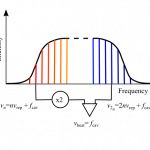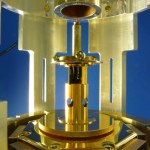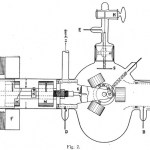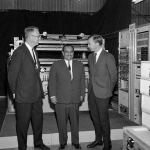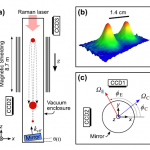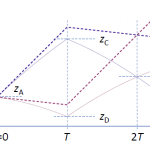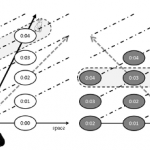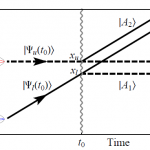Precision Measurement
There's a new Science Express paper on interfering clocks today, which is written up in Physics World, with comments from yours truly. The quote is from a much longer message I sent-- with no expectation that it would end up as anything other than a pull quote, I might add, but I thought the background would be helpful. Since I ended up doing a back-of-the-envelope estimate for that, though, I thought I would reproduce some of the reasoning here.
The basic proposal idea here is to do an atom interferometer inside a Ramsey interferometer for making an atomic clock. That is, before sending the…
I've been really busy with year-end wrap-up stuff, but have also posted a bunch of stuff at Forbes. which I've fallen down on my obligation to promote here... So, somewhat belatedly, here's a collection of physics-y stuff that I've written recently:
-- Using Atoms To Measure Tiny Forces: A post reporting on some very cool atom interferometry experiments, one working to measure the very tiny (but known to exist) force of gravity, the other searching for a possible "fifth force" sort of thing.
-- Making And Shaking New Materials With Ultracold Atoms: A post reporting on a couple more DAMOP…
The editor at Forbes suggested I should write something about the re-start of the Large Hadron Collider, so I did. But being me, I couldn't just do an "LHC, yay!" post, but talk about it in a larger context, as one of three major approaches to filling the gaps in the Standard Model:
The big physics story over the weekend was the re-start of the Large Hadron Collider at CERN, the world’s largest and highest-energy particle accelerator. It was initially started in 2008, but some key circuits failed shortly after it was switched on. A relatively quick patch job allowed it to operate at half its…
I wrote up another piece about football for the Conversation, this time drawing on material from Eureka, explaining how great football players are using scientific thinking:
Seattle Seahawks cornerback Richard Sherman gets called a lot of things. He calls himself the greatest cornerback in the NFL (and Seattle fans tend to agree). Sportswriters and some other players call him a loudmouth and a showboater. Fans of other teams call him a lot of things that shouldn’t see print (even on the internet). One thing you’re not likely to hear anyone on ESPN call Sherman, though, is “scientist.”
And…
Back in August, I gave a talk in Stockholm at the Nordita workshop for science writers, about precision measurement searches for physics beyond the Standard Model. There's now video of this online:
The video quality isn't great, but if you'd like a clearer look at the slides, I've posted them on SlideShare. The talk was divided into two parts, though the video is not:
Part 1:
High Precision, Not High Energy: Using Atomic Physics to Look Beyond the Standard Model (Part I) from Chad Orzel
Part 2:
High Precision, Not High Energy: Using Atomic Physics to Look Beyond the Standard Model (…
Over at Backreaction, Bee has a nice piece on our current age of virality. Toward the end, she discusses some of the ways this applies to science, specifically a quote from this Nature article about collaborative efforts to measure "big G", and a story about a Chinese initiative to encourage collaboration. She writes of the latter, "Essentially, it seems, they’re giving out salary increases for scientists to think the same as their colleagues."
And I agree that this can be a problem-- there's a famous paper I can never find looking at the evolution of the accepted value of some physical…
On Twitter Sunday morning, the National Society of Black Physicsts account retweeted this:
Using Lasers to Lock Down #Exoplanet Hunting #Space
http://t.co/0TN4DDo7LF
— ✨The Solar System✨ (@The_SolarSystem) September 28, 2014
I recognized the title as a likely reference to the use of optical frequency combs as calibration sources for spectrometry, which is awesome stuff. Unfortunately, the story at that link is less awesome than awful. It goes on at some length about the astronomy, then dispenses with the physics in two short paragraphs of joking references to scare-quoted jargon from the…
I didn't write a summary of the third day of "Quantum Boot Camp" to go with my Day One and Day Two summaries for a simple reason: I would've needed to do that on Saturday, and I spent Saturday in transit back to the US. More than that, though, it was harder to summarize than the other two days, because my talk was the middle of three, and thus I spent most of the first talk fiddling with my slides and fretting, and most of the third fighting off the post-talk adrenaline crash.
Happily, Sedeer at Inspiring Science offers a summary of the first two talks, namely Larus Thorlacius from Nordita…
I've gotten a few queries about this "Impossible space drive" thing that has space enthusiasts all a-twitter. This supposedly generates thrust through the interaction of an RF cavity with a "quantum vacuum virtual plasma," which is certainly a collection of four words that turn up in physics papers. An experiment at a NASA lab has apparently tested a couple of these gadgets, and claimed to see thrust being produced. Which has a lot of people booking tickets on the Mars mission that this supposedly enables.
Most physicists I know have reacted to this with some linear combination of "heavy sigh…
A couple of weeks ago, io9 ran a piece about the old accusations that Robert Millikan manipulated his data for the electron charge with the headlineDid a Case of Scientific Misconduct Win the Nobel Prize for Physics? that got a lot of attention. I wasn't as impressed with this as a lot of other people, mostly because it's mostly just adding a clickbait headline to a story that's been around for decades, and doesn't even really engage with the various responses and defenses of Millikan, including this PDF that offers a (to my mind) fairly convincing argument that most of the argument turns on…
In 1967, a team of scientists hauled a big pile of gear-- electronics, particle detectors, a giant slab of iron-- into the burial chamber at the base of one of the pyramids at Giza. This sounds like a scene from a science fiction or fantasy novel-- throw in the fact that their first attempt was interrupted by the Six Day War and you've got an element of a Tim Powers secret history story-- but the goal wasn't the opening of an interdimensional portal or the raising of the dead. Instead, they were using astrophysics to do archaeology: their detectors measured the number of cosmic ray particles…
A little over a year ago, I visited Mark Kasevich's labs at Stanford, and wrote up a paper proposing to use a 10-m atom interferometer to test general relativity. Now, that sounds crazy, but I saw the actual tower when I visited, so it wasn't complete nonsense. And this week, they have a new paper with experimental results, that's free to read via this Physics Focus article. Which might seem to make me blogging it redundant, but I think it's cool enough that I can't resist.
OK, dude, "Multiaxis Inertial Sensing with Long-Time Point Source Atom Interferometry" is not the sexiest title in the…
A few months back, I got a call from a writer at a physics magazine, asking for comments on a controversy within AMO physics. I read a bunch of papers, and really didn't quite understand the problem; not so much the issue at stake, but why it was so heated. When I spoke to the writer (I'm going to avoid naming names as much as possible in this post, for obvious reasons; anyone I spoke to who reads this is welcome to self-identify in the comments), he didn't really get it, either, and after kicking it around for a while, it failed to resolve into a story for either of us-- in his case, because…
Last year, Alan Alda posed a challenge to science communicators, to explain a flame in terms that an 11-year old could understand. this drew a lot of responses, and some very good winners. This year's contest, though still called the "Flame Challenge," asked for an answer to the question "What Is Time?"
This is a little closer to my corner of science, so I considered entering, but as previously noted, I'm crushingly busy at present. And either scripting/ shooting/ editing a video, or doing the necessary work to hack a written response down to the prescribed 300 characters was more time than I…
OK, it's a paper I mentioned here before, when it went up on the arxiv, but the "Comments on Atomic, Molecular, and Optical Physics" article I wrote this summer is up on the Physica Scripta web site now, and for the next not-quite-thirty days it's free to read and download:
Searching for new physics through atomic, molecular and optical precision measurements
We briefly review recent experiments in atomic, molecular and optical physics using precision measurements to search for physics beyond the Standard Model. We consider three main categories of experiments: searches for changes in…
It's a banner day for science explainer things I wrote, as a piece I wrote has just gone live at Tor.com:
Why Gandalf Is Wrong
Even as a kid, reading J. R. R. Tolkien’s The Lord of the Rings at the golden age of twelve or so, Gandalf’s response to Saruman never sat well with me. Splitting white light into its component colors is awesome, and taking things apart is the best way to learn how they work. Knowing how things work is the first step toward making them work better, a process that leads to the technologies that make modern life comfortable enough to, among other things, provide Oxford…
In which we look at a slightly crazy-sounding proposal from my former boss, the experimental realization of which is getting close to completion.
------------
I spent more or less the entire first day of DAMOP a couple of weeks ago going to precision measurement talks. Most of these were relatively sedate (at least by the standards of a sub-field that routinely involves people proposing incredibly difficult experiments), but my boss when I was at Yale, Mark Kasevich, provided the bold proposals I usually expect, in this case suggesting an experiment using an atom interferometer to measure…
I've been busily working on something new, but I'm beginning to think I've been letting the perfect be the enemy of the good-enough-for-this-stage, so I'm setting it aside for a bit, and trying to get caught up with some of the huge number of things that have been slipping. Which includes getting the oil changed in my car, hence, I'm sitting in B&N killing time, which is a good excuse to do some ResearchBlogging.
Last week was a banner week for my corner of physics, with three really cool experiments published. Two of those are on the arxiv, which means I can use images from the paper (…
So, the infamous OPERA result for neutrino speeds seems to be conclusively disproven, traced to a problem with a timing signal. Matt Strassler has a very nice explanation of the test that shows that the whole thing can almost certainly be traced to a timing error that cropped up in 2008. This problem is generally described as resulting from a "loose fiber optic cable," and Matthew Francis's reaction is fairly typical
The main culprit was a fiber optic cable that was slightly out of alignment. This is not quite a "loose wire", as it sometimes has been described: it's far more subtle and harder…
It's been a while since I did any ResearchBlogging posts, because it turns out that having an infant and a toddler really cuts into your blogging time. Who knew? I keep meaning to get back to it, though, and there was a flurry of excitement the other day about a Nature Physics paper proposing a way to search for quantum gravity not with a billion-dollar accelerator, but with a tabletop experiment. There's a write-up at Ars Technica, but that comes at it mostly from the quantum gravity side, which leaves room for a little Q&A from the quantum optics side.
Wait a minute, you said this is in…
